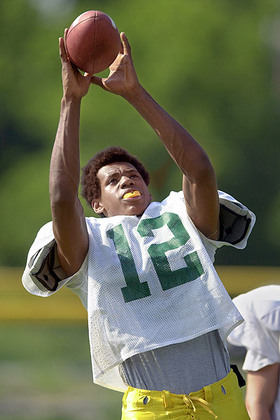 Lebron James was an all-state receiver in high school.
Lebron James was an all-state receiver in high school. The reality is that most kids are not fully developed and finished growing until they are 16-18 years old. In today's society, athletes are often starting to narrow their focus prior to high school. If I had chosen the sport I was best at in the 8th grade, I would have specialized in baseball. I was 5'9" and rail thin but had great hand eye coordination and a good arm. Would I have made it to the majors or even gotten a baseball scholarship? I don't know the answer but I am glad I continued to play multi-sports. Yes I probably was not as proficient at any one sport due to playing the others, but I learned valuable lessons and skills in one sport that translated to the other. The toughness and leadership skills I learned as a quarterback as well as the focus and attention to detail I learned on the baseball field were integral in my growth as a basketball player. I certainly would not have played ACC basketball if it wasn't for a full football scholarship.
We have all heard the stories of burn out as well as the potential for over use injuries. Of course those are concerns but I want to focus on what I feel is the biggest reason why athletes should play multiple sports while developing. Growth as a person and an athlete can only come when you are challenged and pushed outside of your comfort zone. In my opinion, playing multiple sports is the best way to challenge an athlete mentally and physically. The effort and mental toughness it takes to switch your mindset from one sport to another will stretch and grow a young athlete physically and emotionally. The star in one sport might have to learn to be a role player in another. By playing more than one sport, an athlete stokes the competitive fire within them in different ways and that is a great thing.
You might argue that when competing for a college scholarship, you can't afford to not be playing year round because your competition will be. In reality you might be right that someone who focuses on one sport may have more skills at an earlier age. However, I would argue that a smart college coach will look at the fact that you played multiple sports and see the benefit in that. If I am comparing two players in high school one of which has focused exclusively on basketball year round and another who has played multiple sports, which one do you think might make the biggest advances once they go to college? I strongly feel that athletes should play more than one sport at least through their sophomore year of high school. At that point, if one sport sticks out as something they should focus on then go for it. Enough already with the 12 year old phenom who does nothing but play one sport. Push them out of their comfort zone and try something new. If it's not another sport then have them learn an instrument or pick up a hobby. I guarantee in the long run it will be a rewarding experience.
 RSS Feed
RSS Feed
